WET SCRUBBERS
The basic operating principle of a wet scrubber is to pass a gas flow through an atomised spray which then interacts with the gas flow and knocks out contaminants.
Those contaminants can be liquid contaminants, gaseous contaminants or even particulates within the gas flow.
The main objective is to generate a large surface area of liquid for the gas to interact with; the bigger the surface area, the higher the chance of interaction and the better the scrubber will perform.
Therefore, drop size is extremely important; the smaller the drop size, the bigger the surface area for any given volume of liquid sprayed.
It might appear that the smaller the drop size, the better the scrubber will perform. This is true to a certain extent but there are some serious limitations on this.
Another important thing to consider is the range of the spray; spraying the reagent in the one part of the gas flow is pointless. The spray needs to reach over the entire spread of the gas flow and whilst it’s important to ensure it reaches the sides, too much can destroy the spray and thus destroys all that surface area and therefore the detriment of the scrubber’s effectiveness.
Overall, it is key to get good drop size (small drop size) and sufficient coverage to ensure the walls of the scrubber are being hit.
A very fine mist will generate broad surface area, but it will struggle to penetrate through a fast moving gas flow and it may get entrained within the gas flow rather quickly. This results in a lack of coverage which causes streams of big parts of the gas flow that simply won’t be interacting with any of the reagent and so are going to be completely untreated.
An even balance between small drop size and large drop size is needed to ensure the spray is delivered accurately.
The spray angle of the nozzle also needs to be factored into this as big spray angles achieve better coverage. Too much coverage however will cause a large amount of liquid to gather on the walls of the chamber which destroys that drop size. The tension between good drop size and surface area means that having a sufficient drop size to penetrate the gas flow and the correct spray angles to ensure that the right amount is hitting the walls becomes incredibly important so complete coverage of the gas stream can be attained.
Choice of spray nozzle for these wet scrubbers are often our TF Spiral nozzles. These have a good drop size for any given pressure and provide adequate atomisation. The wide variety of spray angles offered by these nozzles, means sufficient coverage as they can move anything from a 60-degree spray angle, all the way up to a 170-degree spray angle.
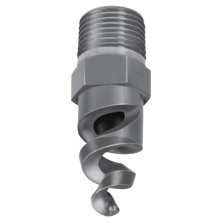
Between that 60 and 170 degree angle, there's a lot of iterations which means the coverage can be optimised without hitting the walls too much.
For narrow spray chambers that can be found in designs such as the Venturi scrubber, the spray needs injecting into the narrow gas stream. The narrowed throat of the scrubber aids with the atomisation process and the best nozzle for this would be our NCK injector nozzles which can come down to 15 or 20 degree spray angles, (much lower than the TF Spiral nozzles).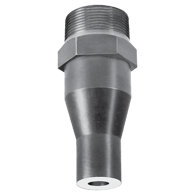
A fair amount of drop size is sacrificed in this process as they won’t atomise as effectively but, the narrow spray angle can be of high importance in certain scrubber designs.
PACKED BED SCRUBBERS
Packed bed scrubbers are still a form of wet scrubber but they generate the necessary surface area in a fundamentally different way.
This design does not rely on the atomisation of the liquid by the spray nozzles to generate that surface area for reaction. Alternatively, the liquid is sprayed onto the top of a packed media bed full of small and very geometrically complex shapes. The liquid trickles through and that complex geometry creates the surface area for the reaction to occur as the gas passes up through that medium.
Drop size and atomisation is not top priority with a packed bed scrubber. Ensuring the fluid reaches over the top of the bed is the main objective as this will lead to good interaction as it evenly trickles down throughout the entire bed.
Again, with these types of scrubbers, our TF Spiral nozzles are the best choice with their 170 degree spray angle that allows a closer positioning to the top of the bed, especially when compared to having narrow angle spray nozzles.
Keeping the head space smaller also reduces the profile of the overall scrubber and this can improve the efficiency of the scrubber and make it more cost effective.
DRY SCRUBBERS
Dry scrubbers are mainly for quench or pre-quench systems as a reagent is not being sprayed to react with the gas. Powder or something similar to this, is used to knock out the contaminants.
Spray nozzles are still used in most cases to quench the gas flow and make it cooler to assist with the scrubbing process; the gas is slowed down to prevent hot gases from damaging the scrubbing system. Drop size is key.
The overall goal is to increase the surface area of the quenching which is normally water. The increased surface area escalates heat transfer which results in rapid evaporation of the liquid onto the gas stream, and this is what produces the cooling.
Most of the cooling is produced by the high latent heat of vaporisation of water; the small amounts of water that are fully vaporised produce peak amounts of cooling.
Nozzle selection for a dry scrubber is focused mainly on keeping the drop size down to ensure a rapid heat transfer is possible.
For small gas flow, our PJ or L Misting nozzles would be most suitable as they are low flow nozzles and produce extremely small drop sizes.
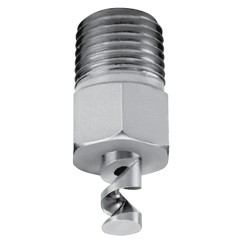
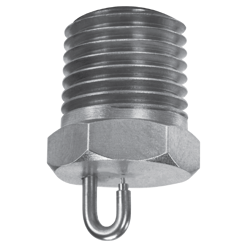
For larger and more variable gas flows that can tolerate some air being added, the nozzle of choice would be our Spiral Air Atomising nozzles.
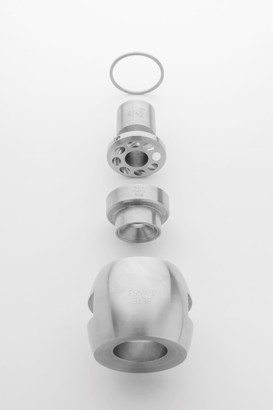
For variable gas flows that require variable cooling, the drop size must remain consistent with variable flow rates of water going in for different cooling loads. The best suited nozzle for this would be our Spillback nozzles which are designed precisely for that purpose.
To read more about nozzle systems and solutions for gas scrubbing applications, visit the SNP website here for lots more information and advice.
Or contact SNP on:
01273 400092
www.spray-nozzle.co.uk












Water Sector Talent Exodus Could Cripple The Sector
Maybe if things are essential for the running of a country and we want to pay a fair price we should be running these utilities on a not for profit...